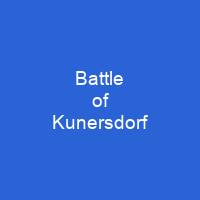The Battle of Kunersdorf: A Turning Point in the Seven Years’ War
Imagine a battlefield where the fate of empires hangs by a thread, and the outcome is decided not just by valor but by strategy, terrain, and sheer luck. The Battle of Kunersdorf on August 12, 1759, near Frankfurt an der Oder in eastern Germany, was such a crucible. This pivotal engagement saw Frederick the Great’s Prussian army face off against a combined force of Russian and Austrian troops led by Pyotr Saltykov and Ernst Gideon von Laudon.
The Strategic Context
Frederick had achieved some early victories, but by 1759, his position was precarious. The Seven Years’ War, which began after the Treaty of Aix-la-Chapelle in 1748, saw Prussia pitted against a formidable coalition that included Russia and Austria. Britain’s support for Frederick only added to the complexity of the conflict.
The Terrain and Fortifications
As the battle unfolded, the terrain played a crucial role. The landscape surrounding Kunersdorf was characterized by knolls, ravines, and marshy fields, which suited itself better to defense than offense. Frederick’s army took up position in this defensive terrain, preparing for battle against the advancing Russian and Austrian forces.
The Allied Plans
Saltykov had expected Austrian reinforcements but only received a wing under Laudon’s command. Their collaboration was complicated by their personalities and mistrust. Saltykov entrenched his troops on a strong position to receive a Prussian attack, while the Russians constructed redans, flèche, glacis, scarps, counterscarps, abatis, and blocked the approaches with fallen trees.
Prussian Plans
While Saltykov prepared for Frederick’s assault from the west, the Prussians reached Reitwein on August 10. Frederick crossed the Oder in the night and moved southward toward Kunersdorf, establishing a staging area near Göritz with about 50,000 men.
The Battle
Prussian activities began at 2:00 am on August 12. Finck’s corps arrived first, followed by Frederick’s army after a grueling 37 km march. Frederick intended to flank his opposition but sent no reconnaissance and realized he would end up facing his enemy instead.
The Initial Assault
Frederick’s army became bogged down in the Reppen Forest due to hot weather, heavy guns, and unstable ground. The Russians thought Finck’s column was the primary force and prepared for battle. By noon, Frederick sent a wave of soldiers toward the Russian position on the Mühlberge, using mixed troops including grenadiers, musketeers, and cuirassiers.
The Turning Point
Despite initial success, the Prussian plan was thwarted by Finck’s failure to make progress at the salient. The Allied superiority of 423 artillery pieces could be brought to bear on the struggling Prussians. The 6th Dragoons and other regiments suffered heavy losses as they continued to advance on the Russian positions near Kunersdorf.
The Aftermath
Frederick’s attempts to rally his troops proved futile as he rode among them, snatching flags in an effort to inspire his soldiers. The Prussian defeat was catastrophic, with over 37 percent of their army killed or wounded. Frederick lost eight regimental colonels, including Seydlitz, Wedel, and Puttkamer.
The Consequences
Despite the high casualties, Saltykov and Laudon remained on the field with intact armies. The Allied forces did not capitalize on their victory by marching against Berlin but retired to Saxony instead. Within days, Frederick’s army had reconstituted itself, recovering to a strength of 32,000 men and 50 artillery pieces.
Frederick the Great’s defeat at Kunersdorf was a turning point in the Seven Years’ War. It marked a significant setback for Prussia but also highlighted the strategic importance of terrain and the critical role of reconnaissance in military operations. The battle remains a testament to the complexities of warfare and the unpredictable nature of conflict.

You want to know more about Battle of Kunersdorf?
This page is based on the article Battle of Kunersdorf published in Wikipedia (retrieved on November 28, 2024) and was automatically summarized using artificial intelligence.







